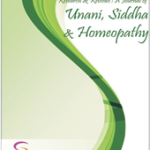Open Access

Mir Idrees Haneef,

Shameem Ahmad Rather,

Fouzia Farooq,
- Research Scholars Department of Moalajat, Regional Research Institute of Unani Medicine (RRIUM) Srinagar
Abstract
Haemorrhoids are one of the most prevalent diseases with significant impact on quality of life. Haemorrhoids commonly known as piles are defined as swollen, inflammed veins around the anus or the lower part of rectum. The most common symptom of haemorrhoids is rectal bleeding and discomfort before or after bowel movements. According to the Unani Physicians, the most common cause of the haemorrhoids is the accumulation of the abnormal melancholic humour and the persons with melancholic temperament are very prone to this disease. Management of haemorrhoids is diverse ranging from conservative, pharmacological to surgical interventions. In Unani System of Medicine, the line of treatment to follow in such diseases is the evacuation of abnormal excessive accumulated humour by concoctive and laxative therapy. In this review, the author will discuss the causes, classification, pathophysiology, clinical manifestations and management of haemorrhoids in unani system of medicine.
Keywords: Haemorrhoids (Bawaseer), Rectal bleeding, Melancholic humour, Concoctive therapy, Conservative
References
1. Khan A. M. Akseer Azam. Idara Kitab al Shifa, New Delhi. January 2011:661-672.
2. kantoori sahib Hasnain ghulam. Kamil-u-sana. Idara Kitab al Shifa, New Delhi. January 2010:516-518.
3. Samarkandi Najeebdin. Sharah Asbaab. sharah asbaab. Idara Kitab al Shifa, New Delhi. October 2009: 530-537.
4. Zehar Ibn Malik abdul. Kitab ul taseer. Urdu Translation: Central Council for Research in Unani Medicine. New Delhi. 1996:152-153.
5. P.C. kousar. Moujazul qanoon.Turky urdu bearue, New dehli.1984:352-354.
6. Qurshi hasan Mohd. Jamia ul hikmat.Aijaz publishing house, New dehli.2011:786-793.
7. Jeelani Ghulam Hakeem.Mukhzanul hikmat.Aijaz publishing house, New dehli.1996. 581-585.
8. Arzani Akbar. Tib akbar. Urdu translation by Hakeem mohd hussain. Faisal publications, jamia masjid deoband. 388-390.
9. Ibn sina. Al Qanoon Fil Tib (Urdu translation by Kantoori GH). Idara kitabul shifa, New dehli. 2010. 985-990.
10. Raazi zakariya. Kitab-ul haawi.Urdu translation: central council for research in unani medicine.2004: vol:11. 27-68.
11. Arzani Akbar mohd. Qurabdeen qadri.Urdu translation; central council for research in unani medicine.2009.536-573.
12. Qurabdeen sarkari. central council for research in unani medicine.2006. 74.
13. Azmi ahmad waseem. Murakabaat Advia; idara kitab us shifa. New delhi. Feb. 2010: vol:1.108,109,179,545.
14. Kareem noor mohd. kimiyai Anasiri. Urdu translation of Qarabadeen Qadri. central council for research in unani medicine.2004.506-521.

Research & Reviews : A Journal of Unani, Siddha and Homeopathy
| Volume | |
| Received | July 23, 2021 |
| Accepted | September 25, 2021 |
| Published | January 25, 2023 |

